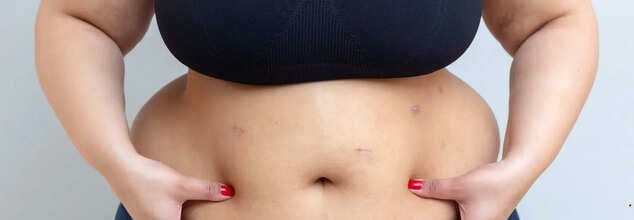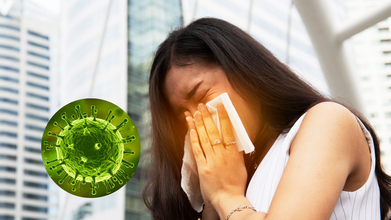- Health Conditions A-Z
- Health & Wellness
- Nutrition
- Fitness
- Health News
- Ayurveda
- Videos
- Medicine A-Z
- Parenting
What Are Two Types Of Belly Fat? How To Lose it?

Belly Fat (Credit: Canva)
Having excessive belly fat is not only a cosmetic concern but it also increases risks of various chronic conditions. While a certain amount of belly fat is normal and protective, accumulating too much can lead to serious health problems, particularly when it involves visceral fat, the fat stored deep within your abdomen.
Types Of Belly Fat
Fat is essential for body's functioning and your body stores it in two forms:
1. Subcutaneous Belly Fat: This is the soft fat located just under your skin, the type you can pinch on your belly. While it can be bothersome aesthetically, it’s generally less dangerous than visceral fat. However, when it accumulates excessively, subcutaneous fat can still contribute to health risks, including type 2 diabetes, heart disease, and certain cancers.
2. Visceral Belly Fat: Deeper in your abdomen, visceral fat surrounds your internal organs such as your liver, pancreas, and kidneys. It’s considered more harmful because it is metabolically active, producing hormones and inflammatory substances that can lead to insulin resistance, increased blood sugar, and inflammation. Visceral fat is strongly linked to chronic conditions like type 2 diabetes, heart disease, and fatty liver disease.
Why Excess Belly Fat Is Harmful?
While both types of belly fat can affect your health, visceral fat is particularly concerning. Even though it accounts for only 10-20% of total body fat, it plays a major role in increasing disease risk. Visceral fat interferes with insulin regulation, raises blood pressure, and contributes to high cholesterol levels. It also promotes systemic inflammation, which is a major factor in the development of metabolic diseases.Visceral fat stored in your waist area is located near portal vein, which carries blood from abdomen to liver. This fat transfers fatty acids, inflammatory proteins and other dangerous substances to your liver. Visceral fat is associated with liver inflammation and high amount of liver fat, which increases the risk of developing conditions like insulin resistance and non-alchoholic fatty liver disease.
A larger waist circumference is a key indicator of abdominal fat, including both subcutaneous and visceral fat. Studies have consistently shown that reducing waist circumference through diet and exercise can improve overall health, including heart and metabolic health.
How To Effectively Lose Belly Fat
Shedding that extra inch from your belly largely depends upon your lifestyle. Here are few alterations you can do to your overall diet.1. First step is cutting out sugary drinks like soda and sugary juices. These drinks are major contributors to visceral fat accumulation. Swap sugary beverages for water or sparkling water to reduce belly fat and improve overall health.
2. Regular exercise, including both aerobic and resistance training, is one of the most effective ways to reduce belly fat. A combination of high-intensity and low-intensity workouts has been shown to promote fat loss.
3. Focus of fibre rich food. Diets high in fiber, especially from vegetables, fruits, and whole grains, are linked to lower levels of belly fat. Fiber helps control appetite and supports healthy digestion.
4. Highly processed foods, such as fast food and packaged snacks, are often linked to higher levels of abdominal fat. Choosing whole, minimally processed foods will support fat loss and improve overall health.
5. Excessive alcohol consumption can lead to increased belly fat. Reducing alcohol intake can support your weight loss efforts.
6. Poor sleep quality and short sleep duration have been associated with increased belly fat. Ensure you're getting enough sleep to support weight management and overall well-being.
7. High-protein diets are shown to help reduce belly fat by promoting satiety and increasing metabolism. You must consider using more lean meats, fish, eggs, and plant-based protein sources in your diet.
8. For some individuals, particularly those with obesity or those at risk for type 2 diabetes, reducing carbohydrate intake can help reduce belly fat. Research suggests that low-carb diets may be more effective at reducing visceral fat than low-fat diets.
Holiday Heart Syndrome Explained: Causes, Symptoms, And How To Stay Safe

Credits: Canva
During the festive months, overindulgence in celebrations can trigger holiday heart syndrome (HHS), a potentially serious yet largely preventable set of heart-related symptoms that tend to rise during this time of year. Most people recover within a day, but HHS can occasionally lead to stroke, heart attack, or other serious complications, according to the Cleveland Clinic. As the holiday season approaches, let’s explore what holiday heart syndrome is, its symptoms, and how to prevent it.
What Is Holiday Heart Syndrome?
First identified by a US physician in 1978, holiday heart syndrome describes irregular heartbeats that occur after binge drinking during the festive season. Research from the University of South Australia shows that alcohol consumption increases by 70 per cent in December compared to other months, while iSelect data predicts Australians may consume around 58 million standard drinks per day during the month. With numbers like these, some caution is warranted.
Atrial fibrillation (AFib) is the specific irregular heartbeat seen in HHS. It occurs when the heart’s upper chambers contract or quiver in a chaotic pattern, which can cause blood to pool in the atrium and form clots. If these clots enter the bloodstream, they can travel to the brain and trigger a stroke.
What Are the Symptoms of Holiday Heart?
Symptoms can include fatigue, dizziness, shortness of breath, anxiety, weakness, confusion, sweating, faintness, unusual tiredness during exercise, rapid or irregular heartbeat, and sensations like fluttering, thumping, pressure, or chest pain.
Dr Mariann R. Piano, Nancy and Hilliard Travis Professor of Nursing at Vanderbilt University School of Nursing, warns, “The scary thing is that people may not notice any symptoms, which makes it a particularly dangerous arrhythmia.”
How Can Drinking Lead to AFib?
Researchers are still investigating exactly how alcohol triggers AFib and how much intake increases the risk. A 2020 study found that people who usually drank at least 10 alcoholic beverages a week lowered their risk of holiday heart syndrome by reducing alcohol consumption. Another study confirmed that eliminating alcohol significantly decreases the chances of developing AFib.
How To Try to Avoid Holiday Heart Syndrome
The Australian Alcohol Guidelines recommend that healthy adults limit alcohol to no more than 10 standard drinks per week to reduce risk.
Experts like Kistler suggest that people with existing heart arrhythmias either abstain or stick to “up to three standard drinks a week.” Drinking mindfully, reducing overall consumption, and staying well hydrated can also help protect your heart.
Tips To Keep Your Heart Healthy During Holidays
Here are some practical ways to protect your heart during the festive season:- Eat smaller, balanced meals and avoid heavy late-night feasts.
- Limit alcohol intake and stay hydrated.
- Continue regular medications without interruption.
- Stay warm and avoid sudden exposure to cold temperatures.
- Maintain light physical activity and avoid strenuous exertion in the early morning.
- Manage stress by taking breaks, sleeping adequately, and avoiding overexertion during travel or celebrations.
- Seek medical help immediately if you experience chest discomfort, unusual fatigue, breathlessness, or palpitations.
Your Rights When You Feel Sexually Exploited By Your Doctor - Explained!

Credits: Gemini
Walking into a clinic or diagnostic centre is never easy. You carry your worries, discomfort, or questions, hoping the people there will guide you with care. Most medical professionals honour that trust. But when someone crosses a line—when a touch feels sexual, unnecessary, or wrong, the sense of safety disappears instantly. It’s not just awkwardness; it’s a violation in a place where you should feel protected.
A recent case in Bengaluru shows just how real this is. A radiologist at a private diagnostic centre was booked for allegedly sexually harassing a woman during a routine scan. When she spoke up, he reportedly threatened her and used abusive language to intimidate her. She had come for an abdominal scan with her husband, expecting a routine procedure, not harassment.
What stays with you after such an experience is not just the shock, it’s the feeling that your trust has been broken. That moment cannot be taken back. What you can do, however, is make sure the system is held accountable, so no one else has to face the same harm.
This raises an important question. Are there legal protections in India that support patients in such situations? To understand this better, we spoke with Anisha Mathur, Founding Partner at Shepherd Law Associates.
What Does India’s New Criminal Law Say?
India’s updated criminal code, the Bharatiya Nyaya Sanhita (BNS), which replaces the Indian Penal Code, is clear that sexual misconduct is a crime no matter where it occurs. Clinics, nursing homes, physiotherapy rooms, diagnostic centers, and even home-based procedure spaces fall under its scope. If a staff member touches a patient in a way that is not medically necessary, ignores privacy during an intimate examination, makes the patient feel uncomfortable, or reveals sexual intent, the act may be treated as a criminal offence.
According to Anisha Mathur, “Unwanted or unnecessary touch can amount to sexual harassment. Any contact that has sexual intent and is not medically justified may be treated as assault with sexual intent. The context, the nature of the procedure and the patient’s consent are all considered while determining this. A medical setting is not a loophole. A uniform is not immunity. Misconduct is misconduct.”
Actions To Take When A Sexual Misconduct Takes Place In A Medical Setting
Once you recognise that the behaviour is inappropriate, you have every right to act. Anisha Mathur suggests the following steps:
Step 1: Pause the interaction
Say you want the procedure to stop. You may ask for a female attendant or any other staff member to be present.
Step 2: Move to a safer area
Walk to the waiting room or any open space within the facility.
Step 3: Note down details
Record the time, the room, what happened and who was involved. Even small details may matter later.
In a larger hospital or diagnostic chain, go to the administration or patient desk and request that your complaint be put in writing. Many such establishments have an Internal Committee (IC) under the Prevention of Sexual Harassment (PoSH) Act, 2013.
If you are in a smaller clinic, nursing home or any space without a complaint system, call 100 or 112. When the officials arrive, ask them to record your statement. If you can reach a lawyer, it helps, because early legal guidance prevents confusion and intimidation.
Anisha adds, “Authorities may ask whether you want a Medico-Legal Certificate (MLC) examination to document physical signs, which is normal. You can request a trusted friend or family member to be with you. You do not need to know the law in that moment. You only need to protect yourself, the law will support you. If something feels wrong, it is wrong. You are allowed to stop the procedure immediately.”
Legal Actions You Can Take After the Incident
Once the initial shock settles, several routes are available:
• Filing a criminal complaint (FIR)
• Requesting disciplinary action from the medical council
• Filing a civil or consumer case if the establishment failed in its duty
Anisha Mathur stresses that both the individual staff member and the institution can be held responsible. This is often how meaningful change begins.
Can a Patient File a Complaint Anonymously?
In many hospitals and clinics, internal systems allow anonymous complaints. For police cases, your identity is needed for investigation, but Indian law protects your privacy strictly. Your name cannot be disclosed publicly. Any attempt to threaten or silence you becomes a separate offence.
Are Hospitals Expected To Have Safety Measures For Patients?
Every medical facility is expected to follow basic standards that protect patients. According to Anisha, these include:
• Clear consent before intimate examinations
• A female attendant upon request
• Privacy safeguards during procedures
• Staff training on professional boundaries
• A channel for patients to raise concerns
If these were ignored or missing, it strengthens the patient’s case. These protections are not optional. They are part of the provider’s legal duty.
Consequences For Staff Who Violate Boundaries
Sexual misconduct by medical staff is treated as seriously as misconduct in any other setting, sometimes more so because patients are vulnerable and rely on the professional’s judgment. Anisha explains, “Under BNS, the staff member can face criminal prosecution leading to arrest, fines, suspension or dismissal, and loss of professional license. Courts have repeatedly said that misusing power in a caregiving role makes the offence more serious, not less.”
Being in a medical space should never turn into an experience marked by fear. Any form of sexual misconduct during care is a violation of your dignity at a moment when you are already exposed and trusting. What happened cannot be undone.
Anisha Mathur stresses this and says, “Your voice can bring accountability. Your action can protect someone else. Your dignity remains yours, and the law stands with you.”
Unique Symptoms Of Influenza A In Canada And How Long Infection Now Last

Credits: iStock and Canva
The world is battling a 'very tough' flu season this year. Already there was super flu, the mutated clade K, and now reports of three children from Ottawa and Eastern Ontario dying due to flu-related complications in the past two weeks have come up. This is the result of influenza A. This strain is currently circulating widely and affecting children more severely than ever.
What Is So Unique About Influenza A?
As per the National Institutes of Health, US, influenza viruses that contains single-stranded RNA that are classified into three types: A, B, and C. Type A and B cause annual epidemics and even pandemics, while type C is a less common disease.
As per the Centers for Disease Control and Prevention (CDC), Influenza A viruses are descendants of the 2009 H1N1 pandemic virus that emerged in the spring of 2009 and caused a flu pandemic. These viruses, scientifically called the "A(H1N1)pdm09 virus," and more generally called "2009 H1N1," have continued to circulate seasonally since 2009 and have undergone genetic and antigenic changes.
Influenza A(H3N2) viruses also change genetically and antigenically. Influenza A(H3N2) viruses have formed many separate, genetically different clades in recent years that continue to co-circulate.
It is a fast-spreading respiratory virus responsible for seasonal flu outbreaks and, at times, global pandemics. It changes quickly through genetic shifts, which makes new strains harder to predict and control. The virus is grouped based on surface proteins called hemagglutinin and neuraminidase, with H1N1 and H3N2 among the most common strains in circulation. It spreads mainly through coughs, sneezes, or close contact and often comes on suddenly, causing fever, cough, body pain, and extreme tiredness. In some cases, it can lead to serious complications, especially in vulnerable groups.
Is There A Difference Between H1N1 and H3N2 Virus?
Both are a type of influenza A virus that causes seasonal flu. However, while H3N2 changes its form regularly, which makes it harder for our immune system to fight it off, H1N1 is also known as swine flu. It is now a regular seasonal flu virus that comes back every year.
Read: Influenza A: Can Flu Kill You? Here's All That You Need To Know
How to differentiate between the two in terms of symptoms?
H3N2 Symptoms
- High fever (often above 101°F)
- Severe body aches and muscle pain
- Extreme tiredness that lasts longer
- Dry cough that can be persistent
- Headache
- Sore throat
- Runny or stuffy nose
- Loss of appetite
- Nausea (especially in children)
H1N1 Symptoms
- Fever (usually moderate)
- Body aches (less severe than H3N2)
- Cough
- Headache
- Sore throat
- Runny nose
- Stomach problems (more common)
- Diarrhea and vomiting (especially in children)
- Chills and sweating
The recovery time of any influenza could last up to 5 to 14 days, the key is to monitor breathing patterns and avoid over medication.
What Is The Best Line Of Defense?
This year, the flu is hitting hard everywhere. While winter flu cases are not uncommon, the virus is changing every day, which causes it to be more severe than ever. The best line of defense in this case is vaccination. Experts have suggested that despite mutation, vaccine provides the best defense.
“The flu vaccine may not always prevent infection, but it significantly reduces the risk of severe illness, hospitalization, and complications,” officials said. They added that the vaccine takes about two weeks to become fully effective, making early vaccination crucial ahead of the holiday season, when virus spread typically increases.
© 2024 Bennett, Coleman & Company Limited

